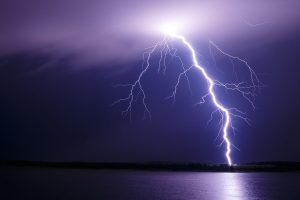Credit to 1stWave on FreeImages.com
Geographical and Climatic Factors
Florida’s peninsular geography plays a significant role in its lightning activity. Surrounded by the warm waters of the Atlantic Ocean and the Gulf of Mexico, Florida experiences a unique convergence of air masses. These warm, moist air masses provide the essential ingredients for thunderstorm development. Additionally, the state’s relatively flat terrain allows thunderstorms to develop and move freely without significant geographical barriers.
Meteorological Dynamics
The frequent occurrence of sea breezes is another critical factor contributing to Florida’s lightning frequency. During the day, the sun heats the land more quickly than the surrounding waters. This differential heating causes the air over the land to rise, creating low-pressure areas. Cooler, moist air from the oceans then flows in to replace the rising warm air, resulting in the formation of sea breeze fronts. When these fronts collide over the peninsula, they force the warm air to rise rapidly, leading to the development of thunderstorms.
Buy lightning detectors here
Florida’s subtropical climate, characterized by hot, humid summers, provides an ideal environment for thunderstorm activity, particularly from late spring through early autumn. The combination of high temperatures and abundant moisture fuels the development of cumulonimbus clouds, which are the precursors to thunderstorms. The peak of the lightning season coincides with the summer months, when the conditions for thunderstorm development are most favorable.
High Population Density and Reporting
Another reason Florida records so many lightning strikes is due to its high population density and extensive lightning detection networks. With a significant number of people living in the state, there is a higher likelihood of lightning strikes being observed and reported.
In conclusion, Florida’s high frequency of lightning strikes is the result of a combination of geographical positioning, climatic conditions, meteorological dynamics, and effective reporting mechanisms, making it a hotspot for one of nature’s most electrifying phenomena.
As an Amazon Associate, I earn from qualifying purchases.







